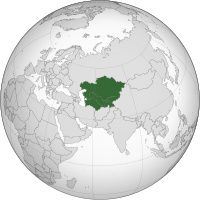Asian cuisine/ja: Difference between revisions
Created page with "アジア料理" |
No edit summary Tags: Mobile edit Mobile web edit |
||
| (28 intermediate revisions by the same user not shown) | |||
| Line 1: | Line 1: | ||
<languages /> | <languages /> | ||
{{Short description|アジアの料理の伝統}} | |||
{{Short description| | {{Culture of Asia sidebar/ja}} | ||
{{Culture of Asia sidebar}} | [[File:Asia (orthographic projection).svg|thumb|[[:en:Asia|アジア]]の位置]] | ||
[[File:Asia (orthographic projection).svg|thumb| | '''アジア料理'''は、[[:en:Asia|アジア]]のいくつかの重要な地域料理スタイルを包含する。中央アジア料理、東アジア料理、北アジア料理、南アジア料理、東南アジア料理、西アジア料理である。料理とは、独特の調理方法と習慣であり、通常、特定の[[:en:culture|文化]]と関連付けられる。アジアは最大かつ最も人口の多い[[:en:continent|大陸]]であり、それぞれ独自の料理を特徴とする多くの文化の拠点である。東洋料理としても知られるアジア料理は、信念、調理方法、そして全工程で使用される特定の食材のために、「社会内の食文化」と見なされている。アジア料理はそのスパイスでも有名である。アジア料理の主要な味覚要因は、「うま味」であり、アジア料理で顕著な強い風味であり、発酵食品や肉エキスを通じて達成できる。 | ||
''' | |||
[[:en:East Asia|東アジア]]や[[:en:Southeast Asia|東南アジア]]の多くの文化に共通する食材には、米、生姜、ニンニク、ゴマ、唐辛子、乾燥玉ねぎ、大豆、豆腐などがある。[[Stir frying/ja|炒め物]]、蒸し物、[[deep frying/ja|揚げ物]]が一般的な調理法である。 | |||
米はほとんどのアジア料理に共通するものの、地域によって好まれる品種は異なる。[[Glutinous rice/ja|もち米]]は[[:en:Laos|ラオス]]の文化、宗教的伝統、そして国民的アイデンティティに深く根付いている。[[Basmati rice/ja|バスマティ米]]は[[:en:Indian subcontinent|インド亜大陸]]で、[[jasmine rice/ja|ジャスミン米]]は[[:en:Southeast Asia|東南アジア]]全域でよく見られる一方、中国では長粒米が、日本と韓国では短粒米が人気である。 | |||
[[Curry/ja|カレー]]は南アジア、東南アジア、東アジアで一般的な料理である。カレー料理はインド亜大陸を起源とする。インドシナ諸国のカレーは通常ココナッツミルクをベースにしており、南西アジア諸国のカレーは通常ヨーグルトをベースにしている。 | |||
[[Curry]] | |||
== 歴史的タイムライン{{Anchor|Historical timeline}} == | |||
== Historical timeline == | アジア文化に大きな影響を与えている側面は食であり、特にアジア料理と調理の様々な伝統的な方法である。多くのアジア文化は、家族やグループが集まって食事をしながら交流したり祝賀したりする伝統を共有しているが、アジアの様々な文化は、歴史、文化、環境の相互作用を通じて、それぞれ独自の民族的・文化的食への取り組みを発展させてきた。アジア料理はしばしば多文化主義と関連付けられ、特定の食品が多くの異なる文化と結びついている。 | ||
== 中央アジア料理{{Anchor|Central Asian cuisine}} == | |||
== Central Asian cuisine == | {{Main/ja|Central Asian cuisine/ja}} | ||
{{Main|Central Asian cuisine}} | |||
<gallery widths="200" heights="200"> | <gallery widths="200" heights="200"> | ||
Central Asia (orthographic projection).svg| | Central Asia (orthographic projection).svg|[[:en:Central Asia|中央アジア]]の位置 | ||
</gallery> | </gallery> | ||
ほとんどの中央アジア諸国は、互いに同様の料理を持ち、また隣国、特に[[:en:Iran|イラン]]や[[:en:Mongolia|モンゴル]]の西アジアおよび東アジアの料理の多くの特徴を取り入れている。例えば、「プロフ」または「オシュ」として知られる料理は、[[pilaf/ja|ピラフ]]の広く普及したバリエーションである。しかし、多くの同じ国では、[[beef/ja|牛肉]]と同様に、[[horse meat/ja|馬肉]]と[[mutton/ja|羊肉]]を最も一般的な肉として使用している。これは[[Mongolian cuisine/ja|モンゴル料理]]に由来する。[[:en:Kazakhstan|カザフスタン]]と[[:en:Kyrgyzstan|キルギス]]では、料理は遊牧生活のニーズを満たすように進化してきた。 | |||
[[Kumis/ja|クミス]]は、[[:en:Turkic peoples|テュルク系民族]]、特に中央アジアで広く普及している飲み物である。 | |||
[[Kumis]] | |||
中央アジアは[[yogurt/ja|ヨーグルト]]の発祥地としても知られている。クミスと同様に、テュルク系民族の間で広く普及している。 | |||
== 東アジア料理{{Anchor|East Asian cuisine}} == | |||
== East Asian cuisine == | {{Main/ja|East Asian cuisine/ja}} | ||
{{Main|East Asian cuisine}} | |||
<gallery widths="200" heights="200"> | <gallery widths="200" heights="200"> | ||
East Asia (orthographic projection).svg| | East Asia (orthographic projection).svg|[[:en:East Asia|東アジア]]の位置 | ||
</gallery> | </gallery> | ||
東アジア料理には、[[Chinese cuisine/ja|中国料理]]、[[Hong Kong cuisine/ja|香港料理]]、[[Japanese cuisine/ja|日本料理]]、[[Korean cuisine/ja|韓国料理]]、[[Macanese cuisine/ja|マカオ料理]]、[[Mongolian cuisine/ja|モンゴル料理]]、[[Taiwanese cuisine/ja|台湾料理]]、そして[[Tibetan cuisine/ja|チベット料理]]が含まれる。これは世界で最も人口の多い地域であることを考えると、多くの地域料理がある(特に中国)。主食の例としては、[[rice/ja|米]]、[[noodle/ja|麺]]、[[mung bean/ja|緑豆]]、[[soybean/ja|大豆]]、[[seafood/ja|魚介類]](日本は魚介類の1人当たりの消費量が最も多い)、[[mutton/ja|羊肉]](モンゴル)、[[bok choy/ja|白菜]]、そして[[tea/ja|茶]]などが挙げられる。 | |||
== 北アジア料理{{Anchor|North Asian cuisine}} == | |||
== North Asian cuisine== | |||
<gallery widths="200" heights="200"> | <gallery widths="200" heights="200"> | ||
North Asia (orthographic projection).svg| | North Asia (orthographic projection).svg|[[:en:North Asia|北アジア]]の位置 | ||
</gallery> | </gallery> | ||
北アジア料理は、北アジア全体がロシア連邦の一部であるため、しばしば[[Russian cuisine/ja|ロシア料理]]と同義である。しかし、シベリアの一部の文化や地域、例えば[[:en:Yakuts|ヤクート族]](またはサハ族)や[[Yamal cuisine/ja|ヤマール料理]]には、奥深い料理がある。[[:en:Buryats|ブリヤート族]]も独自の料理を持つが、関連する[[:en:Mongolian cuisine|モンゴル族]]の料理と非常に似ている。 | |||
[[Pelmeni/ja|ペリメニ]]は、元々は[[:en:Great Perm|ペルム]]または[[:en:Yugra|ウゴル]]の料理であったが、有名な料理としてロシア料理の主流に取り入れられた。しかし、その発祥地であるヤマール料理の一部と見なすこともできる。一部では、中国の[[wonton/ja|ワンタン]]を簡略化したものだと推測されている。[[:en:Siberia|シベリア]]では、ペリメニは長い冬の間、中の肉を保存するために屋外で凍らせられる。[[:en:Yamal Peninsula|ヤマール半島]]では、他の種類の乾燥や保存方法が一般的である。ほとんどの北シベリア料理の主要な食材には、魚と[[Vaccinium vitis-idaea/ja|コケモモ]](ヨーロッパや北アメリカではリンゴンベリーとして知られることもある)が含まれる。ヤクート族は、他の多くの[[:en:Turkic peoples|テュルク系民族]]と同様に、伝統的に[[kumis/ja|クミス]]を一般的な飲み物として楽しんでいる | |||
[[Pelmeni]] | |||
== 南アジア料理{{Anchor|South Asian cuisine}} == | |||
== South Asian cuisine == | {{Main/ja|South Asian cuisine/ja}} | ||
{{Main|South Asian cuisine}} | |||
<gallery widths="200" heights="200"> | <gallery widths="200" heights="200"> | ||
File:South Asia (orthographic projection) without national boundaries, with ambiguities indicated.svg| | File:South Asia (orthographic projection) without national boundaries, with ambiguities indicated.svg|南アジアの位置 | ||
</gallery> | </gallery> | ||
南アジア料理には、[[:en:Indian subcontinent|インド亜大陸]]の[[cuisine/ja|料理]]が含まれる。この地域の食材は一般的にスパイスが豊富であるが、世界各地の多国籍料理文化が融合している。料理は様々な種類の唐辛子、黒胡椒、クローブ、調味料、その他のハーブやスパイスで味付けされる。風味付けされたバターと[[ghee/ja|ギー]]の使用が多くの場所で顕著である。ウコン、コリアンダー、クミンはよくカレーに使われる。 | |||
大多数の人々は、調理にマスタード油、ピーナッツ油、ひまわり油、大豆油を多く使う傾向がある。[[Puri (food)/ja|プーリー]]を作るのに精製油を使うのは非常に有名である。[[Puri bhaji/ja|プーリー・バジ]]、[[idli/ja|イドゥリ]]、[[Dosa (food)/ja|ドーサ]]、[[dal baati/ja|ダル・バーティ]]、[[Litti (cuisine)/ja|リッティ]]は、インド料理の中で最も人気があり代表的な料理である。 | |||
野菜は通常、この地域の主食である[[chapati/ja|チャパティ]]と呼ばれるパンの一種と一緒に食べられる。米は通常、北インドでは[[dal/ja|ダル]]と一緒に湿らせて食べたり、南インドではカードと一緒に食べたりする。 | |||
紅茶とコーヒーはどこでも人気があり、前者はどの街角でも手に入る。卵料理も同様に手軽に手に入る。 | |||
一般的な肉には、ラム、ヤギ、魚、鶏肉が含まれる。[[:en:Hinduism|ヒンドゥー教]]では牛が神聖視されているため、[[beef/ja|牛肉]]は[[:en:Western world|西洋]]料理ほど一般的ではない。牛肉の禁止は、牛の肉、そしてある程度[[yak/ja|ヤク]]にも及ぶ。[[Pork/ja|豚肉]]はすべてのムスリムにとって[[:en:haram|ハラーム]](禁忌)とされており、一部のヒンドゥー教徒には避けられている。他の少数派も暴力を避けるために肉の使用を禁じている。魚は南インド、スリランカ、ベンガル地方、すなわちバングラデシュとインドの西ベンガル州で一般的に食される。北部の食事は主に小麦やその他の主要な作物で構成されている。 | |||
== 東南アジア料理{{Anchor|Southeast Asian cuisine}} == | |||
== Southeast Asian cuisine == | {{Main/ja|Southeast Asian cuisine/ja}} | ||
{{Main|Southeast Asian cuisine}} | |||
<gallery widths="200" heights="200"> | <gallery widths="200" heights="200"> | ||
Southeast Asia (orthographic projection).svg| | Southeast Asia (orthographic projection).svg|[[:en:Southeast Asia|東南アジア]]の位置 | ||
</gallery> | </gallery> | ||
東南アジア料理は、[[Kaffir lime/ja|ライム]]、[[coriander/ja|コリアンダー]]/[[cilantro/ja|シラントロ]]、[[basil/ja|バジル]]などの柑橘類やハーブのような風味を特徴とする、軽く調理され、強い芳香成分を持つ料理に重点を置いている。この地域の食材は東アジア料理とは対照的で、ソースの代わりに[[fish sauce/ja|魚醤]]を使用し、[[galangal/ja|ガランガル]]、[[tamarind/ja|タマリンド]]、[[lemongrass/ja|レモングラス]]などの食材が含まれる。調理法は、[[stir-frying/ja|炒め物]]、煮物、蒸し物のバランスがとれている。 | |||
== 西アジア料理{{Anchor|West Asian cuisine}} == | |||
== West Asian cuisine == | {{Main/ja|West Asian cuisine/ja}} | ||
{{Main|West Asian cuisine}} | |||
<gallery widths="200" heights="200"> | <gallery widths="200" heights="200"> | ||
Western Asia (orthographic projection).svg| | Western Asia (orthographic projection).svg|[[:en:West Asia|西アジア]]の位置 | ||
</gallery> | </gallery> | ||
西アジア料理は、中東料理と大きく重複し、[[:en:South Caucasus|南コーカサス]]地域も含まれる。 | |||
西アジア料理は、西アジアの様々な国や民族の[[cuisine/ja|料理]]である。この地域の料理は多様でありながら、ある程度の均一性を持っている。一般的に使われる食材には、[[olive/ja|オリーブ]]と[[olive oil/ja|オリーブオイル]]、[[pita/ja|ピタ]]、[[honey/ja|蜂蜜]]、[[sesame/ja|ゴマ]]、[[Phoenix dactylifera/ja|ナツメヤシ]]、[[sumac/ja|スマック]]、[[chickpea/ja|ひよこ豆]]、[[mentha/ja|ミント]]、[[parsley/ja|パセリ]]などがある。人気のある料理には、[[kibbeh/ja|キッベ]]や[[shawarma/ja|シャワルマ]]などがある。 | |||
穀物は、歴史的にも今日でも、西アジアの食生活の基礎を成している。[[Wheat/ja|小麦]]と[[rice|米/ja]]が主要で好まれる主食源である。[[Barley/ja|大麦]]もこの地域で広く使われており、[[maize/ja|トウモロコシ]]も一部の地域では一般的になっている。パンは普遍的な主食であり、事実上すべての階級やグループによって、ほとんどすべての食事で何らかの形で食べられている。 | |||
バターと精製バター(セムナとしても知られる)は、伝統的に好まれる調理油である。オリーブオイルは地中海沿岸地域で普及している。キリスト教徒は、肉や乳製品が除外される四旬節中にこれを使用し、ユダヤ人は肉と乳製品の混合を避けるため、バターのような動物性脂肪の代わりにこれを使用する。 | |||
ラム肉とマトンは常に西アジアで好まれてきた肉である。豚肉はイスラム教とユダヤ教の両方で禁止されており、そのためこの地域ではほとんど食べられない。肉料理の中でも目立つのは、焼肉、つまり[[kebab/ja|ケバブ]]である。米、ブルグル、またはパンと共に供される肉と野菜の煮込み料理は、この地域におけるもう一つの肉料理の形態である。 | |||
野菜と豆類は、西アジアの大多数の人々の主要な主食である。これらは茹でたり、煮込んだり、焼いたり、詰め物をしたり、肉や米と一緒に調理される。緑の葉物野菜の中では、多くの種類のキャベツ、ほうれん草、フダンソウが広く使われている。タマネギやニンニクなどの根菜や球根野菜、さらにはニンジン、カブ、ビートも同様に一般的である。 | |||
== 関連項目 == | |||
* [[List of Asian cuisines/ja]] | |||
* [[List of Asian cuisines]] | |||
{{Asian topic/ja|| cuisine}}{{Asia topics}}{{Cuisine/ja}} | |||
{{Asian topic|| cuisine}}{{Asia topics}}{{Cuisine}} | |||
{{Portal bar|Asia|Food}} | {{Portal bar|Asia|Food}} | ||
{{DEFAULTSORT:Asian Cuisine}} | {{DEFAULTSORT:Asian Cuisine}} | ||
[[Category:Asian cuisine| ]] | [[Category:Asian cuisine| ]] | ||
| Line 141: | Line 90: | ||
[[Category:Cuisine by continent]] | [[Category:Cuisine by continent]] | ||
[[Category:Eastern cuisine]] | [[Category:Eastern cuisine]] | ||
{{二次利用|date=24 May 2025, at 09:54}} | {{二次利用/ja|date=24 May 2025, at 09:54}} | ||
Latest revision as of 20:20, 25 May 2025
| シリーズの一部 |
| アジア文化 |
|---|

アジア料理は、アジアのいくつかの重要な地域料理スタイルを包含する。中央アジア料理、東アジア料理、北アジア料理、南アジア料理、東南アジア料理、西アジア料理である。料理とは、独特の調理方法と習慣であり、通常、特定の文化と関連付けられる。アジアは最大かつ最も人口の多い大陸であり、それぞれ独自の料理を特徴とする多くの文化の拠点である。東洋料理としても知られるアジア料理は、信念、調理方法、そして全工程で使用される特定の食材のために、「社会内の食文化」と見なされている。アジア料理はそのスパイスでも有名である。アジア料理の主要な味覚要因は、「うま味」であり、アジア料理で顕著な強い風味であり、発酵食品や肉エキスを通じて達成できる。
東アジアや東南アジアの多くの文化に共通する食材には、米、生姜、ニンニク、ゴマ、唐辛子、乾燥玉ねぎ、大豆、豆腐などがある。炒め物、蒸し物、揚げ物が一般的な調理法である。
米はほとんどのアジア料理に共通するものの、地域によって好まれる品種は異なる。もち米はラオスの文化、宗教的伝統、そして国民的アイデンティティに深く根付いている。バスマティ米はインド亜大陸で、ジャスミン米は東南アジア全域でよく見られる一方、中国では長粒米が、日本と韓国では短粒米が人気である。
カレーは南アジア、東南アジア、東アジアで一般的な料理である。カレー料理はインド亜大陸を起源とする。インドシナ諸国のカレーは通常ココナッツミルクをベースにしており、南西アジア諸国のカレーは通常ヨーグルトをベースにしている。
歴史的タイムライン
アジア文化に大きな影響を与えている側面は食であり、特にアジア料理と調理の様々な伝統的な方法である。多くのアジア文化は、家族やグループが集まって食事をしながら交流したり祝賀したりする伝統を共有しているが、アジアの様々な文化は、歴史、文化、環境の相互作用を通じて、それぞれ独自の民族的・文化的食への取り組みを発展させてきた。アジア料理はしばしば多文化主義と関連付けられ、特定の食品が多くの異なる文化と結びついている。
中央アジア料理
-
中央アジアの位置
ほとんどの中央アジア諸国は、互いに同様の料理を持ち、また隣国、特にイランやモンゴルの西アジアおよび東アジアの料理の多くの特徴を取り入れている。例えば、「プロフ」または「オシュ」として知られる料理は、ピラフの広く普及したバリエーションである。しかし、多くの同じ国では、牛肉と同様に、馬肉と羊肉を最も一般的な肉として使用している。これはモンゴル料理に由来する。カザフスタンとキルギスでは、料理は遊牧生活のニーズを満たすように進化してきた。
クミスは、テュルク系民族、特に中央アジアで広く普及している飲み物である。
中央アジアはヨーグルトの発祥地としても知られている。クミスと同様に、テュルク系民族の間で広く普及している。
東アジア料理
-
東アジアの位置
東アジア料理には、中国料理、香港料理、日本料理、韓国料理、マカオ料理、モンゴル料理、台湾料理、そしてチベット料理が含まれる。これは世界で最も人口の多い地域であることを考えると、多くの地域料理がある(特に中国)。主食の例としては、米、麺、緑豆、大豆、魚介類(日本は魚介類の1人当たりの消費量が最も多い)、羊肉(モンゴル)、白菜、そして茶などが挙げられる。
北アジア料理
-
北アジアの位置
北アジア料理は、北アジア全体がロシア連邦の一部であるため、しばしばロシア料理と同義である。しかし、シベリアの一部の文化や地域、例えばヤクート族(またはサハ族)やヤマール料理には、奥深い料理がある。ブリヤート族も独自の料理を持つが、関連するモンゴル族の料理と非常に似ている。
ペリメニは、元々はペルムまたはウゴルの料理であったが、有名な料理としてロシア料理の主流に取り入れられた。しかし、その発祥地であるヤマール料理の一部と見なすこともできる。一部では、中国のワンタンを簡略化したものだと推測されている。シベリアでは、ペリメニは長い冬の間、中の肉を保存するために屋外で凍らせられる。ヤマール半島では、他の種類の乾燥や保存方法が一般的である。ほとんどの北シベリア料理の主要な食材には、魚とコケモモ(ヨーロッパや北アメリカではリンゴンベリーとして知られることもある)が含まれる。ヤクート族は、他の多くのテュルク系民族と同様に、伝統的にクミスを一般的な飲み物として楽しんでいる
南アジア料理
-
南アジアの位置
南アジア料理には、インド亜大陸の料理が含まれる。この地域の食材は一般的にスパイスが豊富であるが、世界各地の多国籍料理文化が融合している。料理は様々な種類の唐辛子、黒胡椒、クローブ、調味料、その他のハーブやスパイスで味付けされる。風味付けされたバターとギーの使用が多くの場所で顕著である。ウコン、コリアンダー、クミンはよくカレーに使われる。
大多数の人々は、調理にマスタード油、ピーナッツ油、ひまわり油、大豆油を多く使う傾向がある。プーリーを作るのに精製油を使うのは非常に有名である。プーリー・バジ、イドゥリ、ドーサ、ダル・バーティ、リッティは、インド料理の中で最も人気があり代表的な料理である。
野菜は通常、この地域の主食であるチャパティと呼ばれるパンの一種と一緒に食べられる。米は通常、北インドではダルと一緒に湿らせて食べたり、南インドではカードと一緒に食べたりする。
紅茶とコーヒーはどこでも人気があり、前者はどの街角でも手に入る。卵料理も同様に手軽に手に入る。
一般的な肉には、ラム、ヤギ、魚、鶏肉が含まれる。ヒンドゥー教では牛が神聖視されているため、牛肉は西洋料理ほど一般的ではない。牛肉の禁止は、牛の肉、そしてある程度ヤクにも及ぶ。豚肉はすべてのムスリムにとってハラーム(禁忌)とされており、一部のヒンドゥー教徒には避けられている。他の少数派も暴力を避けるために肉の使用を禁じている。魚は南インド、スリランカ、ベンガル地方、すなわちバングラデシュとインドの西ベンガル州で一般的に食される。北部の食事は主に小麦やその他の主要な作物で構成されている。
東南アジア料理
-
東南アジアの位置
東南アジア料理は、ライム、コリアンダー/シラントロ、バジルなどの柑橘類やハーブのような風味を特徴とする、軽く調理され、強い芳香成分を持つ料理に重点を置いている。この地域の食材は東アジア料理とは対照的で、ソースの代わりに魚醤を使用し、ガランガル、タマリンド、レモングラスなどの食材が含まれる。調理法は、炒め物、煮物、蒸し物のバランスがとれている。
西アジア料理
-
西アジアの位置
西アジア料理は、中東料理と大きく重複し、南コーカサス地域も含まれる。
西アジア料理は、西アジアの様々な国や民族の料理である。この地域の料理は多様でありながら、ある程度の均一性を持っている。一般的に使われる食材には、オリーブとオリーブオイル、ピタ、蜂蜜、ゴマ、ナツメヤシ、スマック、ひよこ豆、ミント、パセリなどがある。人気のある料理には、キッベやシャワルマなどがある。
穀物は、歴史的にも今日でも、西アジアの食生活の基礎を成している。小麦と米/jaが主要で好まれる主食源である。大麦もこの地域で広く使われており、トウモロコシも一部の地域では一般的になっている。パンは普遍的な主食であり、事実上すべての階級やグループによって、ほとんどすべての食事で何らかの形で食べられている。
バターと精製バター(セムナとしても知られる)は、伝統的に好まれる調理油である。オリーブオイルは地中海沿岸地域で普及している。キリスト教徒は、肉や乳製品が除外される四旬節中にこれを使用し、ユダヤ人は肉と乳製品の混合を避けるため、バターのような動物性脂肪の代わりにこれを使用する。
ラム肉とマトンは常に西アジアで好まれてきた肉である。豚肉はイスラム教とユダヤ教の両方で禁止されており、そのためこの地域ではほとんど食べられない。肉料理の中でも目立つのは、焼肉、つまりケバブである。米、ブルグル、またはパンと共に供される肉と野菜の煮込み料理は、この地域におけるもう一つの肉料理の形態である。
野菜と豆類は、西アジアの大多数の人々の主要な主食である。これらは茹でたり、煮込んだり、焼いたり、詰め物をしたり、肉や米と一緒に調理される。緑の葉物野菜の中では、多くの種類のキャベツ、ほうれん草、フダンソウが広く使われている。タマネギやニンニクなどの根菜や球根野菜、さらにはニンジン、カブ、ビートも同様に一般的である。
関連項目
| この記事は、クリエイティブ・コモンズ・表示・継承ライセンス3.0のもとで公表されたウィキペディアの項目Asian cuisine(24 May 2025, at 09:54編集記事参照)を翻訳して二次利用しています。 |





